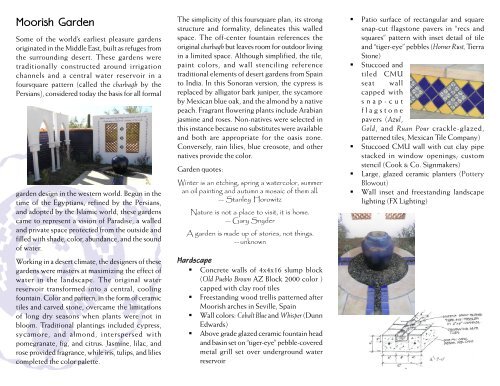You also want an ePaper? Increase the reach of your titles
YUMPU automatically turns print PDFs into web optimized ePapers that Google loves.
<strong>Moorish</strong> <strong>Garden</strong><br />
Some of the world’s earliest pleasure gardens<br />
originated in the Middle East, built as refuges from<br />
the surrounding desert. These gardens were<br />
traditionally constructed around irrigation<br />
channels and a central water reservoir in a<br />
foursquare pattern (called the charbagh by the<br />
Persians), considered today the basis for all formal<br />
garden design in the western world. Begun in the<br />
time of the Egyptians, refined by the Persians,<br />
and adopted by the Islamic world, these gardens<br />
came to represent a vision of Paradise, a walled<br />
and private space protected from the outside and<br />
filled with shade, color, abundance, and the sound<br />
of water.<br />
Working in a desert climate, the designers of these<br />
gardens were masters at maximizing the effect of<br />
water in the landscape. The original water<br />
reservoir transformed into a central, cooling<br />
fountain. Color and pattern, in the form of ceramic<br />
tiles and carved stone, overcame the limitations<br />
of long dry seasons when plants were not in<br />
bloom. Traditional plantings included cypress,<br />
sycamore, and almond, interspersed with<br />
pomegranate, fig, and citrus. Jasmine, lilac, and<br />
rose provided fragrance, while iris, tulips, and lilies<br />
completed the color palette.<br />
The simplicity of this foursquare plan, its strong<br />
structure and formality, delineates this walled<br />
space. The off-center fountain references the<br />
original charbagh but leaves room for outdoor living<br />
in a limited space. Although simplified, the tile,<br />
paint colors, and wall stenciling reference<br />
traditional elements of desert gardens from Spain<br />
to India. In this Sonoran version, the cypress is<br />
replaced by alligator bark juniper, the sycamore<br />
by Mexican blue oak, and the almond by a native<br />
peach. Fragrant flowering plants include Arabian<br />
jasmine and roses. Non-natives were selected in<br />
this instance because no substitutes were available<br />
and both are appropriate for the oasis zone.<br />
Conversely, rain lilies, blue creosote, and other<br />
natives provide the color.<br />
<strong>Garden</strong> quotes:<br />
Winter is an etching, spring a watercolor, summer<br />
an oil painting and autumn a mosaic of them all.<br />
— Stanley Horowitz<br />
Nature is not a place to visit, it is home.<br />
— Gary Snyder<br />
A garden is made up of stories, not things.<br />
— unknown<br />
Hardscape<br />
Concrete walls of 4x4x16 slump block<br />
(Old Pueblo Brown AZ Block 2000 color )<br />
capped with clay roof tiles<br />
Freestanding wood trellis patterned after<br />
<strong>Moorish</strong> arches in Seville, Spain<br />
Wall colors: Cobalt Blue and Whisper (Dunn<br />
Edwards)<br />
Above grade glazed ceramic fountain head<br />
and basin set on “tiger-eye” pebble-covered<br />
metal grill set over underground water<br />
reservoir<br />
Patio surface of rectangular and square<br />
snap-cut flagstone pavers in “recs and<br />
squares” pattern with inset detail of tile<br />
and “tiger-eye” pebbles (Horner Rust, Tierra<br />
Stone)<br />
Stuccoed and<br />
tiled CMU<br />
seat wall<br />
capped with<br />
snap-cut<br />
flagstone<br />
pavers (Azul,<br />
Gold, and Ruan Pour crackle-glazed,<br />
patterned tiles, Mexican Tile Company)<br />
Stuccoed CMU wall with cut clay pipe<br />
stacked in window openings; custom<br />
stencil (Cook & Co. Signmakers)<br />
Large, glazed ceramic planters (Pottery<br />
Blowout)<br />
Wall inset and freestanding landscape<br />
lighting (FX Lighting)
<strong>Moorish</strong> <strong>Garden</strong> Plant List<br />
Map Location<br />
Botanical Name Common Name(s)<br />
Use Water<br />
Typical<br />
Height x Width Highest<br />
Landscape Use<br />
Secondary Use<br />
Lowest Water Use<br />
Medium Water Use<br />
3 Acalypha stachys Rasberry fuzzies 0.6 x 1 GC L M ✔<br />
23 Aquilegia chrysantha Golden columbine 1.5 x 1 P WF M H ✔<br />
29 Asclepias subulata Skeleton milkweed 2 x 1.5 P A L ✔<br />
33 Astrolepis sinuata Wax-leaved star fern 2 x 2 F A M H<br />
43 Brahea armata Mexican blue palm 30 x 10 PA M H ✔<br />
44 Brahea elegans Elegant palm 6 x 6 PA A M H ✔<br />
54 Carex tumerericola Berkley sedge 0.75 x 1.5 G GT M H<br />
98 Guayacan coulteri Blue creosote 5 x 5 SH L M<br />
100 Heucherea sanguinea Coral bells 0.6 x 1 P GC M H ✔<br />
101 Hesperaloe parviflora Red yucca 2 x 4 A L ✔<br />
109 Jasminum sambac Arabian jasmine 6 x 6 V SH H<br />
114 Justicia candicans Mexican honeysuckle 4 x 4 SH M H ✔<br />
126 Merremia aurea Gold coin vine 12 x 10 V L M ✔<br />
153 Prunus andersonii Arizona peach 12 x 8 T SH L M<br />
155 Punica granatum ‘Nana’ Dwarf pomegranate 4 x 3 SH M H<br />
156 Quercus oblongifolia Mexican blue oak 30 x 30 T M H<br />
161 Rosa ‘Flutterby’ Flutterby climbing rose 4 x 8 SH V H<br />
167 Ruellia brittoniana Ruellia 2 x 2 P M H ✔<br />
175 Salvia clevelandii Chapparal sage 4 x 5 SH L M ✔<br />
181 Salvia greggii ‘white’ White autumn sage 3 x 3 SH M H ✔<br />
184 Salvia greggii ‘Furman’s Red’ Furman’s Red sage 1.5 x 2 SH M H ✔<br />
206 Telosiphonia brachysiphon White trumpet 1 x 3 GC CN M H ✔<br />
TCP Greenhouse<br />
Key<br />
A - accent CN - container GC - groundcover PA - palm T - tree ✔ ✔ - generally available in <strong>Tohono</strong> <strong>Chul</strong> <strong>Park</strong> Greenhouse<br />
B - bulb F - fern GT - grass/turf SU - succulent V - vine<br />
C - cactus G - grass P - perennial SH - shrub WF - wildflower





